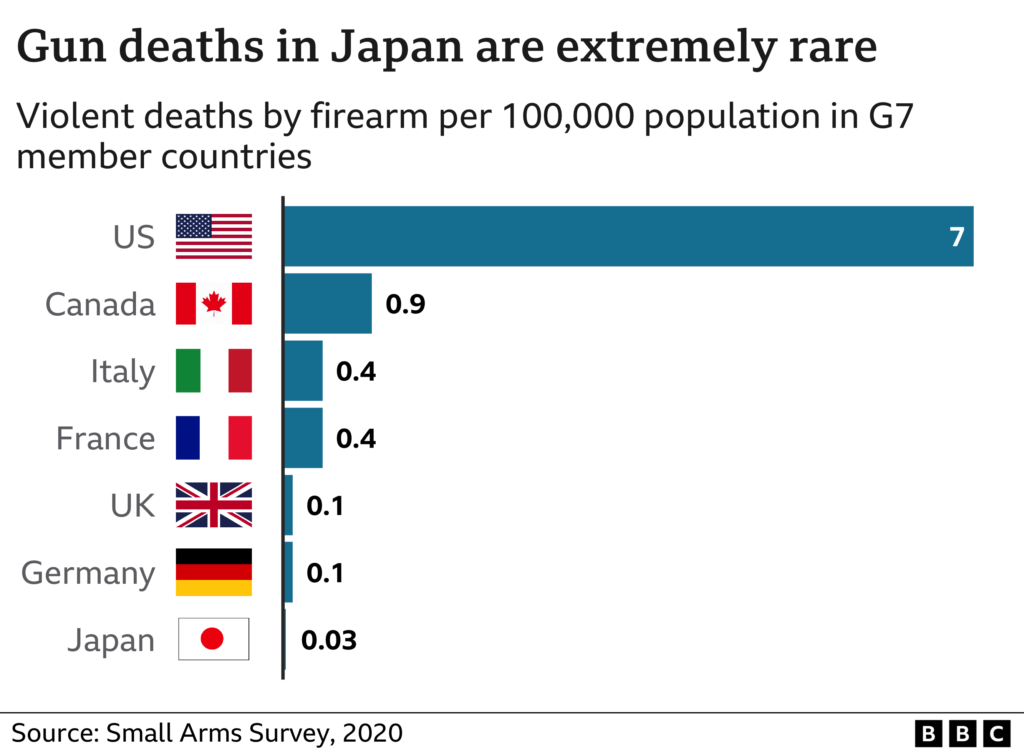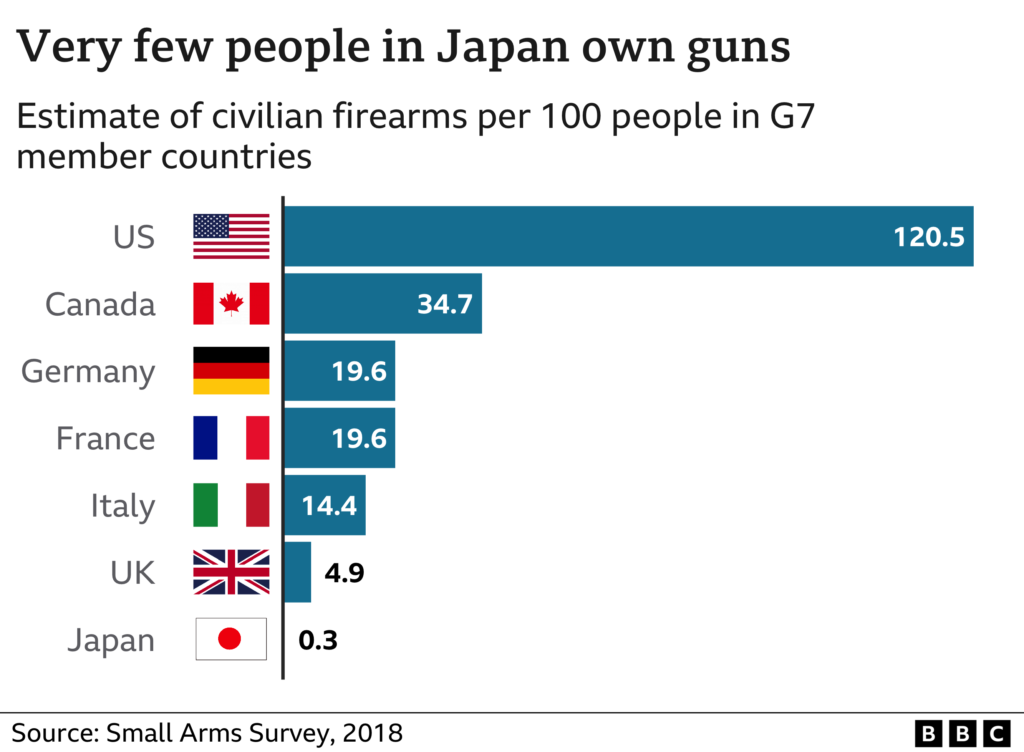Amid the assassination of Japan’s longest-serving prime minister, Shinzo Abe, one detail stood out: the weapon used was homemade. This has led to speculation about whether it was a 3D printed gun. While details about the firearm and the murder itself are still trickling out, initial footage seems to suggest that the gun was not 3D printed.
The gun used to shoot at Shinzo Abe (former Prime Minister) was undoubtedly homemade. pic.twitter.com/a6lp1y6UcV
— Sumi (墨すみ) (@Sumi_ENG) July 8, 2022
Japanese Gun Laws
According to a 1958 Japanese law, “The possession of firearms and swords is prohibited.” Handguns are banned, but weapons can be obtained for hunting after passing mental health, drug, and criminal records checks. To receive the necessary three-year license, a day of weapons training, including a written test and firing range evaluation with a 95 percent score, is required. Additionally, the police must be told where the gun and ammunition are stored (located separately from one another and under lock and key). The authorities inspect these weapons once a year.
As a result, Japan has the lowest level of gun ownership per capita of the G7 group of wealthy nations, at only 0.3 per 100 people. This compares to the U.S., which has an overwhelming 120.5 per 100 individuals. Japan also has the lowest rate of gun deaths at 0.03 per 100,000 people, compared to the U.S. at 7 per 100,000 people.
A Homemade Shotgun
So, while the suspect arrested in the assassination, 41-year-old Tetsuya Yamagami, was a member of the navy’s Maritime Self-Defense Force for three years, where he received weapons training, it may not have been easy for him to obtain a professionally manufactured gun. Yamagami reportedly told authorities that he made the firearm. In addition to explosives, Japanese police have found more elaborate versions of the murder weapon at his home.
#Japan: Police have now seized a number of improvised firearms from the home of Tetsuya Yamagami (the man who shot and killed former PM Shinzo Abe). The weapons include both a 5 and 9-barreled shotgun, which appear to be electrically fired. pic.twitter.com/0qR1fLDrq8
— POPULAR FRONT (@PopularFront_) July 8, 2022
There have not yet been many details about the gun itself, but images seem to show two metal barrels, possibly aluminum, attached to a wood base, all wrapped in black tape.
“I think the first interesting observation is that it’s clearly electrically fired,” N. R. Jenzen-Jones, an arms and munitions intelligence specialist and Director of the U.K.-based Armament Research Services (ARES), told the Daily Beast. “There’s electrical wire passing through each of those end caps that you can see in one of the images. That indicates to me that it’s an electrically-fired firearm. My hunch is that it’s probably a muzzle-loading design. It’s probably a smooth-bore weapon—by which I mean unrifled, like a shotgun—but again, that’s not a certainty.”

The weapon alleged to have been used in the assassination of former Prime Minister of Japan Shinzo Abe. Image courtesy of NHK/Facebook.
There didn’t seem to be any 3D printed parts unless they were hidden beneath the tape. However, because the rest of the device was so crude, it’s difficult to imagine the need for a 3D printer to make any of it. Delhi Television. Former Chief White House Correspondent for CNN Jessica Yellin was one journalist who speculated about whether the gun was 3D printed. The Daily Beast also brought up the use of 3D printed weapons as a growing threat in its coverage of the murder.
View this post on Instagram
3D Printed Gun Arrests Are Growing
Given the nature of the event, the topic of 3D printing as a means of producing weapons is already being brought up. We can go through the regular arguments made by the additive manufacturing industry about why the technology is not exactly ideal for gunsmithing:
- Cheap, accessible printers would not make a firearm sufficiently strong for practical use. It would likely shatter upon firing.
- There are other, likely easier methods for fabricating a gun
Regardless of their threat level, arrests for 3D printed weapons are on the rise, as 3DPrint.com Senior Analyst Vanesa Listek recently reported, tripling in number in less than two years. She has also noted that fully 3D printed guns are not likely to be the norm. Instead, hybrid firearms are where the segment is headed. This would typically include weapons made up of a combination of 3D printed and traditionally made or off-the-shelf parts, and market-bought weapons with 3D printed receivers.
In one instance, 3D printing was used to make a device that could convert an AR-15, legal in the U.S., into an automatic machine gun. These were then sold online disguised as a portable coat hanger by an associate of the far-right wing boogaloo group. Similarly, 3D printed guns were found at a terrorist attack at a synagogue in Halle, Germany. Because high-temperature 3D printers are becoming less expensive and metal filaments have arrived on the market, we may see more capable parts being made for this application.
With that in mind, the topic will certainly not going to go away as much as anyone would like it to. What the case of Abe’s assassination raises is the fact that gun control can reduce gun deaths to the point where they are very rare, but it obviously cannot eliminate violence altogether.
Subscribe to Our Email Newsletter
Stay up-to-date on all the latest news from the 3D printing industry and receive information and offers from third party vendors.
You May Also Like
Formnext Day Three: Rock & Zoll
The biggest news on day three was, of course, the reactions to the band at the exhibitor’s party. The soirée was well attended, with the crowd rocking on until early...
3D Printing Webinar and Event Roundup: October 27, 2024
This week, Stratasys and Würth Additive Group continue their tours, and ICAM 2024 takes places in Atlanta, Georgia. Other offerings include an AM Symposium, webinars about 3D printing dental implants...
Flashforge Guider 3 Ultra 3D Printer Review: The Redemption Arc?
Disclosure: The Guider 3 Ultra was provided to me by Flashforge free of charge for the purpose of this review. I have not received any other compensation. All opinions expressed...
NAMIC’s Global Additive Manufacturing Summit: Innovation, Sustainability, and Strategic Collaboration in Singapore
Once again, we joined business people and researchers from around the world in Singapore for Global Additive Manufacturing Summit. Singapore’s national 3D printing partner, the National Additive Manufacturing Innovation Cluster...






































